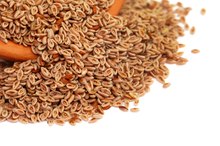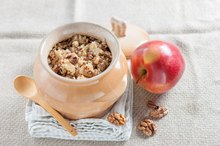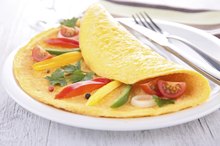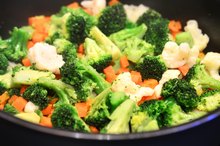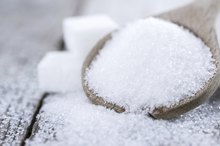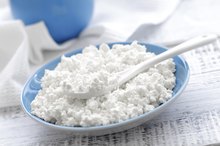What does fact checked mean?
At Healthfully, we strive to deliver objective content that is accurate and up-to-date. Our team periodically reviews articles in order to ensure content quality. The sources cited below consist of evidence from peer-reviewed journals, prominent medical organizations, academic associations, and government data.
- National Institute of Diabetes and Digestive and Kidney Disease: Diverticular Disease
- Academy of Nutrition and Dietetics: Diabetes and Diet
The information contained on this site is for informational purposes only, and should not be used as a substitute for the advice of a professional health care provider. Please check with the appropriate physician regarding health questions and concerns. Although we strive to deliver accurate and up-to-date information, no guarantee to that effect is made.
What Should a Diabetic & Diverticulitis Patient Eat?
The diet for diabetes and diverticulosis, which is a condition characterized by small protruding pouches along the colon wall, are similar and play important roles in controlling both conditions. But if you're experiencing diverticulitis, which is when the pouches become inflamed, swollen or infected, you may be worried about how you're going to manage your diabetes due to the extreme differences in diet recommendations. Consult your doctor immediately if you're experiencing abdominal pain and think it may be a diverticulitis flare-up.
Diet for Diabetes and Diverticulosis
What you eat is important for management of both your diabetes and diverticulosis. It is especially important that you control the amount of carbs at each meal since they have the greatest impact on your blood sugar.
When you have diabetes, eating more high-fiber foods has the added benefit of aiding in blood sugar control by delaying stomach emptying and helping to prevent spikes in blood sugar.
Diet for Diverticulitis
List of Roughage Foods
Learn More
As your condition improves, you can start eating solid food as directed by your doctor. To continue to allow your colon to heal, you will eat a low-fiber diet. Low-fiber food options include:
- white bread
- white rice
- pasta
- low-fiber cereal
- applesauce
- melon
- soft-cooked vegetables
- eggs
- tender meat
Diabetes and Clear Liquid Diet
As a diabetic, you may be concerned about eating foods such as gelatin, juice and fruit ice on your clear liquid diet due to their sugar content. However, you still need some carbs to help maintain blood sugar.
On the clear liquid diet, you need 200 grams of carbs a day divided into three meals or about 65 grams of carbs at each meal, says the Medical University of South Carolina 4. For example, a 65-gram carb clear liquid meal might contain 1 cup of apple juice, 1 cup of gelatin and 1 cup of clear broth.
- As a diabetic, you may be concerned about eating foods such as gelatin, juice and fruit ice on your clear liquid diet due to their sugar content.
Diabetes and Low-Fiber Diet
Can Diabetics Eat Rye Bread & Pumpernickel Bread?
Learn More
The low-fiber diet may also be a little different than your usual diet for diabetes, but it is an important step in healing your diverticulitis. To aid in blood sugar control on a low-fiber diet, try to eat about the same number of carbs at each meal using your low-fiber food choices as you would on your normal diet. For example, a 60-gram, low-fiber breakfast might include 1 1/2 cups of a low-fiber cereal such as corn flakes with 1 cup of nonfat milk and 1 cup of cantaloupe cubes.
Once your symptoms start to improve, which usually occurs in about two to four days, according to UCSF Medical Center, you can start to add fiber back to your diet in increments of 5 grams to 15 grams, advancing to your usual diet as tolerated.
- The low-fiber diet may also be a little different than your usual diet for diabetes, but it is an important step in healing your diverticulitis.
- To aid in blood sugar control on a low-fiber diet, try to eat about the same number of carbs at each meal using your low-fiber food choices as you would on your normal diet.
Related Articles
References
- National Institute of Diabetes and Digestive and Kidney Disease: Diverticular Disease
- University of California at San Francisco Medical Center: Divertular Disease and Diet
- Canadian Diabetes Association: Fibre
- Medical University of South Carolina: Understanding My Diet Order: Diabetic Clear Liquid Diet
- University of Arkansas Division of Agriculture: The Exchange List System for Diabetic Meal Planning
- Nallapeta NS, Foris LA, Tuma F, et al. Diverticulosis. In: StatPearls. Updated December 13, 2019.
- Carabotti M, Annibale B. Treatment of diverticular disease: an update on latest evidence and clinical implications. DIC. 2018;7:1-11. doi:10.7573/dic.212526
- University of California, San Francisco Health. Diverticular disease and diet.
- American Society of Colon and Rectal Surgeons. Diverticular disease expanded version.
- Rezapour M, Ali S, Stollman N. Diverticular disease: An update on pathogenesis and management. Gut Liver. 2018;12(2):125-132. doi:10.5009/gnl16552
- Strate LL, Keeley BR, Cao Y, Wu K, Giovannucci EL, Chan AT. Western dietary pattern increases, and prudent dietary pattern decreases, risk of incident diverticulitis in a prospective cohort study. Gastroenterology. 2017;152(5):1023-1030.e2. doi:10.1053/j.gastro.2016.12.038
- Dahl C, Crichton M, Jenkins J, et al. Evidence for dietary fibre modification in the recovery and prevention of reoccurrence of acute, uncomplicated diverticulitis: A systematic literature review. Nutrients. 2018; 10(2):137-. doi:10.3390/nu10020137
- Eglash A, Lane CH. What is the most beneficial diet for patients with diverticulosis? J Fam Pract. 2006 September;55(9):813-814.
- Office of Disease Prevention and Health Promotion. Dietary Guidelines 2015-2020.
- Barroso AO, Quigley EM. Diverticula and diverticulitis: time for a reappraisal. Gastroenterology & Hepatology. 2015;11(10):680-8.
- Strate LL, Morris AM. Epidemiology, pathophysiology, and treatment of diverticulitis. Gastroenterology. 2019;156(5):1282-1298.e1. doi:10.1053/j.gastro.2018.12.033
- Okawa Y, Fukudo S, Sanada H. Specific foods can reduce symptoms of irritable bowel syndrome and functional constipation: a review. BioPsychoSocial Med. 2019;13:10. doi:10.1186/s13030-019-0152-5
- NIH National Institute of Diabetes and Digestive and Kidney Diseases. Eating, diet, & nutrition for diverticular disease. Updated May 2016.
- HealthLink BC. Healthy eating guidelines for people with diverticular disease. Updated April 2019.
- Severi C, Carabotti M, Cicenia A, Pallotta L, Annibale B. Recent advances in understanding and managing diverticulitis. F1000 Res. 2018;7:971-. doi:10.12688/f1000research.14299.1
- Dashti HS, Mogensen KM. Recommending small, frequent meals in the clinical care of adults: a review of the evidence and important considerations. Nutr Clin Pract. 2016;32(3):365-377. doi:10.1177/0884533616662995
- Harvard T.H. Chan. Carbohydrates and blood sugar.
- Today’s Dietician. Fiber & irritable bowel syndrome – strategies for counseling patients. Updated August 2016.
- McRorie, JW. Evidence-based approach to fiber supplements and clinically meaningful health benefits, part 2. Nutrition Today. 2015;50(2):90-97. doi:10.1097/NT.0000000000000089
- Stanford Hospital & Clinics. Low fiber diet for diverticulitis. Updated January 2014.
- Abdullah MMH, Gyles CL, Marinangeli CPF, Carlberg JG, Jones PJH. Dietary fibre intakes and reduction in functional constipation rates among Canadian adults: a cost-of-illness analysis. Food & Nutrition Research. 2017;59(1):28646. doi:10.3402/fnr.v59.28646
- The Oregon Clinic. BRAT diet for nausea, vomiting, or diarrhea.
- Uno Y, Velkinburgh JCv. Logical hypothesis: low FODMAP diet to prevent diverticulitis. WJGPT. 2016;7(4):503-512. doi:10.4292/wjgpt.v7.i4.503
- Harvard Medical School Harvard Health Publishing. Diverticular disease prevention and treatment. Updated February 2011.
- Ünlü C, Daniels L, Vrouenraets B, Boermeester M. A systematic review of high-fibre dietary therapy in diverticular disease. Int J Colorectal Dis. 2011;27(4):419-427. doi:10.1007/s00384-011-1308-3
- Weir SBS, Akhondi H. Bland Diet. In:StatPearls. Updated March 9, 2019.
Writer Bio
Jill Corleone is a registered dietitian and health coach who has been writing and lecturing on diet and health for more than 15 years. Her work has been featured on the Huffington Post, Diabetes Self-Management and in the book "Noninvasive Mechanical Ventilation," edited by John R. Bach, M.D. Corleone holds a Bachelor of Science in nutrition.


